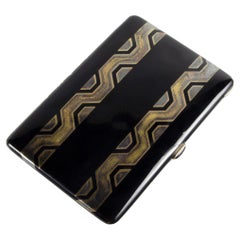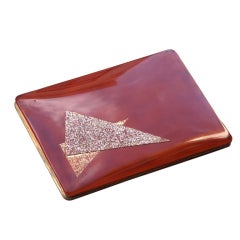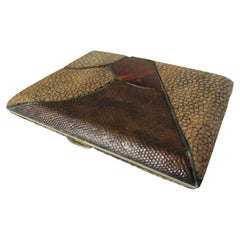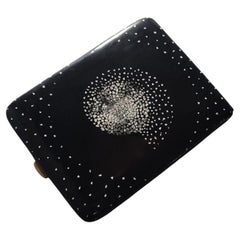Dunand Cigarette Case
Vintage 1930s French Art Deco Snuff Boxes and Tobacco Boxes
Bronze
Vintage 1930s French Art Deco Tobacco Accessories
Metal, Bronze, Copper, Enamel, Tin
Early 20th Century French Art Deco Boxes and Cases
Recent Sales
Early 20th Century French Art Deco Tobacco Accessories
Gold Plate, Silver
Vintage 1920s French Art Deco Collectible Jewelry
Eggshell, Lacquer
People Also Browsed
Vintage 1920s French Art Deco Figurative Sculptures
Bronze
21st Century and Contemporary American Mid-Century Modern Sofas
Upholstery
Antique Early 1900s Austrian Art Nouveau Dressers
Mirror, Beech
Vintage 1930s Swedish Art Deco Vases
Stoneware
Vintage 1920s Unknown Art Deco Decorative Boxes
Wood
Early 20th Century American Art Deco Historical Memorabilia
Sterling Silver
Vintage 1910s European Retro Choker Necklaces
Diamond, Platinum
Vintage 1920s French Art Deco Decorative Boxes
Blown Glass
Vintage 1920s Austrian Art Deco Doors and Gates
Opal, Brass, Nickel
Early 20th Century Swiss Art Deco Desk Accessories
Sterling Silver
Vintage 1950s American Modernist Brooches
Diamond, Tourmaline, Gold, 18k Gold, Yellow Gold
Vintage 1920s Italian Art Deco Loveseats
Wood
Antique 1890s European Victorian Drop Necklaces
Diamond, Opal, 18k Gold, Silver
Mid-20th Century French Art Deco Jewelry Boxes
Multi-gemstone, Silver
Early 20th Century French Art Deco Decorative Boxes
Brass
Vintage 1920s French Art Deco Cabinets
Birdseye Maple, Mother-of-Pearl, Wood
Jean Dunand for sale on 1stDibs
A prolific talent, Jean Dunand was one of the most extraordinary and emblematic designers of the early 20th century. He produced well over a thousand Art Deco works in an almost dizzying array of media. He is best remembered for his exquisite creations in lacquer and metal, but he also worked as a sculptor, mosaicist, portraitist and goldsmith. The Swiss-born Parisian designer imagined jewelry, tapestries, fabrics for haute couture and, during World War I, even a helmet for soldiers with an adjustable visor.
Dunand’s clients included fashion designers Jeanne Lanvin, Madeleine Vionnet and Elsa Schiaparelli, as well as Josephine Baker, who used his vases and screens for her stage sets. She also posed nude for him, and her likeness appears on several lacquer panels. He collaborated with Robert Mallet-Stevens on a boutique for the Swiss leather-goods brand Bally on Paris’s boulevard de la Madeleine, and he lacquered furniture for both Eugène Printz and Émile-Jacques Ruhlmann.
The two highlights of his professional life, however, were no doubt his participation in the International Exhibition of Modern Decorative and Industrial Arts in Paris in 1925 and the decor he imagined for a number of luxury ocean liners, the largest and most prestigious of which was the Normandie, which first set sail in May 1935.
At the 1925 exhibition, from which Art Deco derives its name, Dunand made his mark not only with a series of four monumental hammered-copper vases, decorated with striking geometric patterns in lacquer consisting of squares, triangles, chevrons and undulating lines, but also with the sleek and stylish smoking room he designed for the Pavillon de la Société des Artisans Décorateurs.
Born Jules-John Dunand in 1877 (he Frenchified his first name later) close to Geneva in Switzerland, his first career was as a sculptor. He moved to Paris in 1897 and won a gold medal at the Exposition universelle de 1900 for a bronze proof titled Quo vadis. Five years later, he had turned his attention almost exclusively to the decorative arts. In an ensuing interview, he explained, “The desire to earn a living was partly responsible for my abandoning what is known as ‘fine art.’”
In 1912, Dunand met the Japanese lacquer master Seizo Sugawara, who initiated him into the secrets of the medium’s age-old techniques. It was not until 1921, however, that he presented his first pieces of lacquer furniture. Dunand was not the only Art Deco designer to use the material (Eileen Gray famously did so too), but he employed it much more prolifically and decoratively.
By 1924, he was at the head of a workshop of nearly 60 employees producing objects that ranged from boxes and trays to card tables and screens, many of which bore breathtakingly beautiful motifs consisting of interlocking lines and geometric shapes. By 1927, he had abandoned abstract patterns, favoring instead rich and complex figurative designs, largely featuring animals against stylized backgrounds of leaves and flowers, an aesthetic not far removed from the paintings of Henri Rousseau.
Dunand continued his work relentlessly until his death, in 1942 at the age of 65.
After World War II, Art Deco went completely out of style, and Dunand’s work was largely neglected until the mid-1970s. Since then, it has gained something of a cult following. Karl Lagerfeld, Yves Saint Laurent, Andy Warhol and Marc Jacobs all had Dunand creations in their collections.
Find vintage Jean Dunand decorative objects, ceramics and other Art Deco works on 1stDibs.
A Close Look at Art-deco Furniture
Art Deco furniture is characterized by its celebration of modern life. More than its emphasis on natural wood grains and focus on traditional craftsmanship, vintage Art Deco dining chairs, tables, desks, cabinets and other furniture — which typically refers to pieces produced during the 1920s and 1930s — is an ode to the glamour of the “Roaring Twenties.”
ORIGINS OF ART DECO FURNITURE DESIGN
- Emerged in the 1920s
- Flourished while the popularity of Art Nouveau declined
- Term derives from 1925’s Exposition Internationale des Arts Décoratifs et Industriels Modernes (International Exhibition of Modern Decorative and Industrial Arts) in Paris, France
- Informed by Ancient Egypt, Cubism, Futurism, Louis XVI, De Stijl, modernism and the Vienna Secession; influenced Streamline Moderne and mid-century modernism
CHARACTERISTICS OF ART DECO FURNITURE DESIGN
- Bold geometric lines and forms, floral motifs
- Use of expensive materials such as shagreen or marble as well as exotic woods such as mahogany, ebony and zebra wood
- Metal accents, shimmering mirrored finishes
- Embellishments made from exotic animal hides, inlays of mother-of-pearl or ivory
ART DECO FURNITURE DESIGNERS TO KNOW
VINTAGE ART DECO FURNITURE ON 1STDIBS
Few design styles are as universally recognized and appreciated as Art Deco. The term alone conjures visions of the Roaring Twenties, Machine Age metropolises, vast ocean liners, sleek typography and Prohibition-era hedonism. The iconic movement made an indelible mark on all fields of design throughout the 1920s and ’30s, celebrating society’s growing industrialization with refined elegance and stunning craftsmanship.
Widely known designers associated with the Art Deco style include Émile-Jacques Ruhlmann, Eileen Gray, Maurice Dufrêne, Paul Follot and Jules Leleu.
The term Art Deco derives from the name of a large decorative arts exhibition held in Paris in 1925. “Art Deco design” is often used broadly, to describe the work of creators in associated or ancillary styles. This is particularly true of American Art Deco, which is also called Streamline Moderne or Machine Age design. (Streamline Moderne, sometimes known as Art Moderne, was a phenomenon largely of the 1930s, post–Art Nouveau.)
Art Deco textile designers employed dazzling floral motifs and vivid colors, and while Art Deco furniture makers respected the dark woods and modern metals with which they worked, they frequently incorporated decorative embellishments such as exotic animal hides as well as veneers in their seating, case pieces, living room sets and bedroom furniture.
From mother-of-pearl inlaid vitrines to chrome aviator chairs, bold and inventive works in the Art Deco style include chaise longues (also known as chaise lounges) and curved armchairs. Today, the style is still favored by interior designers looking to infuse a home with an air of luxury and sophistication.
The vintage Art Deco furniture for sale on 1stDibs includes dressers, coffee tables, decorative objects and more.




